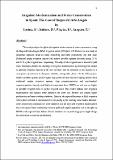Por favor, use este identificador para citar o enlazar a este item:
http://hdl.handle.net/10261/27372COMPARTIR / EXPORTAR:
 SHARE SHARE
 CORE
BASE CORE
BASE
|
|
| Visualizar otros formatos: MARC | Dublin Core | RDF | ORE | MODS | METS | DIDL | DATACITE | |

| Título: | Irrigation modernization and water conservation in Spain: The case of Riegos del Alto Aragón |
Autor: | Lecina Brau, Sergio CSIC; Isidoro, Daniel; Playán Jubillar, Enrique CSIC ORCID ; Aragüés Lafarga, Ramón CSIC | Palabras clave: | Irrigation efficiency; Sprinkler irrigation; Surface irrigation; Water accounting; Water depletion; Water quality; Water productivity Sprinkler irrigation Surface irrigation Water accounting Water depletion Water quality Water productivity |
Fecha de publicación: | oct-2010 | Editor: | Elsevier | Citación: | Lecina S, Isidoro D, Playán E, Aragüés R. Irrigation modernization and water conservation in Spain: The case of Riegos del Alto Aragón. Agricultural Water Management 97 (10): 1663-1675 (2010) | Resumen: | This study analyzes the effects of irrigation modernization on water conservation, using the Riegos del Alto Aragón (RAA) irrigation project (NE Spain, 123354 ha) as a case study. A conceptual approach, based on water accounting and water productivity, has been used. Traditional surface irrigation systems and modern sprinkler systems currently occupy 73% and 27% of the irrigated area, respectively. Virtually all the irrigated area is devoted to field crops. Nowadays, farmers are investing on irrigation modernization by switching from surface to sprinkler irrigation because of the lack of labour and the reduction of net incomes as a consequence of reduction in European subsidies, among other factors. At the RAA project, modern sprinkler systems present higher crop yields and more intense cropping patterns than traditional surface irrigation systems. Crop evapotranspiration and non-beneficial evapotranspiration (mainly wind drift and evaporation loses, WDEL) per unit area are higher in sprinkler irrigated than in surface irrigated areas. Our results indicate that irrigation modernization will increase water depletion and water use. Farmers will achieve higher productivity and better working conditions. Likewise, the expected decreases in RAA irrigation return flows will lead to improvements in the quality of the receiving water bodies. However, water productivity computed over water depletion will not vary with irrigation modernization due to the typical linear relationship between yield and evapotranspiration and to the effect of WDEL on the regional water balance. Future variations in crop and energy prices might change the conclusions on economic productivity. | Descripción: | 44 Pag., 3 Tabl., 3 Fig. The definitive version is available at: http://www.sciencedirect.com/science/journal/03783774 | Versión del editor: | http://dx.doi.org/10.1016/j.agwat.2010.05.023 | URI: | http://hdl.handle.net/10261/27372 | DOI: | 10.1016/j.agwat.2010.05.023 | ISSN: | 0378-3774 |
| Aparece en las colecciones: | (EEAD) Artículos |
Ficheros en este ítem:
| Fichero | Descripción | Tamaño | Formato | |
|---|---|---|---|---|
| PlayanE_AgrWatManagem_2010.pdf | 296,33 kB | Adobe PDF |  Visualizar/Abrir |
CORE Recommender
SCOPUSTM
Citations
128
checked on 19-abr-2024
WEB OF SCIENCETM
Citations
119
checked on 23-feb-2024
Page view(s)
775
checked on 20-abr-2024
Download(s)
300
checked on 20-abr-2024
Google ScholarTM
Check
Altmetric
Altmetric
NOTA: Los ítems de Digital.CSIC están protegidos por copyright, con todos los derechos reservados, a menos que se indique lo contrario.
